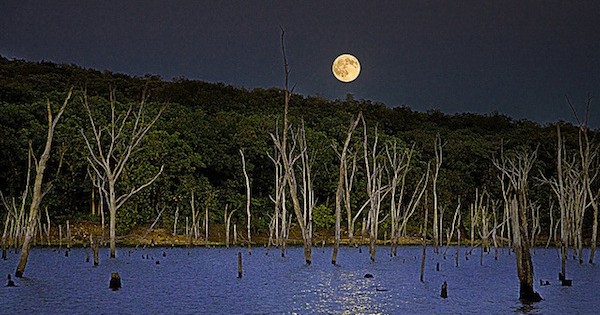
In James Thurber’s delightful short story Many Moons, 10-year-old Princess Lenore falls ill of a surfeit of raspberry tarts, and when her father, the King, asks her what her heart desires, she asks for the moon. The King consults his wise men. The Lord High Chamberlain tells him the moon is made of molten copper, “and it is bigger than the room the Princess lies in”; the Royal Wizard proclaims it made of green cheese and twice as big as the palace. The Royal Mathematician insists that the moon “is round and flat like a coin, only it is made of asbestos, and it is half the size of this kingdom. Furthermore, it is pasted on the sky.”
Planetary scientists may be more methodical in their measurements, but like the sages in Thurber’s story they are still arguing about what the moon is made of and how it formed. They do know that, like Earth, the moon has a crust, a mantle, and a core, and that the core may be made of solid iron surrounded by a molten layer of the same metal. But the moon’s iron constitutes only 10 percent of its mass; in contrast, Earth’s mass is 30 percent iron. Analyses of samples brought back to Earth with the 1970s Apollo missions revealed that minerals in the moon’s mantle, called silicates, are chemically identical to those found in Earth’s outer layers—and different from those found in meteorites from Mars. Both the moon and Earth contain the same compositions of chromium, titanium, and tungsten.
These similarities and differences have led to much speculation about the moon’s origins. The “canonical” theory, according to Robin Canup, of the Southwest Research Institute in Boulder, Colorado, is that a Mars-sized planet slammed into the early Earth, producing a disk of debris that amalgamated into the moon. As she describes in a recent commentary in the journal Nature, such colossal collisions were common in our solar system 4.5 billion years ago, when Earth came into being.
But there are problems with this scenario, as Canup explained in a podcast interview with Nature. “When you have an impact by a Mars-size object, the debris that’s ejected into orbit—from which the moon then forms—that debris originates from the impacting planet, rather than from the Earth,” she said. “Now, that could produce a moon with the same composition as the Earth, if the impactor had had the identical composition to the Earth. That is an extremely improbable event. So this has been the major stumbling block.”
One model of the moon’s origin,proposed by Harvard University planetary scientists Matija Ćuk and Sarah Stewart, posits that a planet smaller than Mars hurtled into an Earth that was already rotating rapidly because of an earlier collision. This impact would act like a bullet to detonate material from Earth into orbit. Canup’s theory is that two planets, each half Earth’s mass, collided, and the moon and planet that formed as a result each consist of approximately “half impactor and half target material.”
In Thurber’s story, it is the Court Jester who finds a solution to Princess Lenore’s impossible request. Back in planetary reality, Canup believes that a mission to Venus could help reveal the answer. “The only other planet from which we have samples is Mars,” Canup told me via email. But the composition of Mars meteorites is very different from that of Earth. “If, for example, it turned out that Venus was very similar in composition to the Earth, Mars would then appear an outlier, and it would then seem that the moon-forming impactor could have had a composition similar to that of the Earth too.” This would make the moon’s origins easier to explain.
Camp also shares Lenore’s lunar enchantment. “I have been working on the lunar origin problem from several different perspectives for 20 years now,” Canup told me. “In general I am fascinated by the moon because of its close relationship to the Earth. Every human has gazed upon it.”

